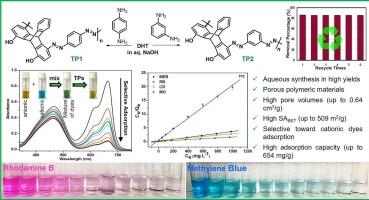选择性阳离子染料吸附的可回收三叶烯基低聚物
IF 5.1
3区 工程技术
Q1 CHEMISTRY, APPLIED
引用次数: 0
摘要
在水介质中合成了两种具有高BET表面积(高达509 m2 g−1)和孔隙体积(高达0.64 cm3 g−1)的三烯基多孔低聚物(TP1和TP2),并使用不同的分析方法对其进行了表征。三烯部分的包合使低聚物具有永久孔隙。TP1在初始浓度为5mg L−1的情况下,仅使用2mg的低聚物,在20分钟内就能高效去除阳离子染料,MEB去除率超过80%,RB去除率超过78%。结果表明,这种低聚物对染料的吸附具有很高的敏感性。TP1和TP2在室温下对MEB的最大吸附量分别为283 mg g−1和278 mg g−1,对RB的最大吸附量分别为654 mg g−1和649 mg g−1。TPs选择性地从阳离子和阴离子染料的二元混合物中吸附阳离子染料,反映了低聚物对阳离子染料的选择性。TP1和TP2均表现出良好的可回收性,最多可回收5次,而吸附容量没有明显损失。本文章由计算机程序翻译,如有差异,请以英文原文为准。

Recyclable triptycene-based oligomers for selective cationic dye adsorption
Two triptycene-based porous oligomers (TP1 and TP2) having high BET surface areas (up to 509 m2 g−1) and pore volumes (up to 0.64 cm3 g−1) were synthesized in an aqueous medium and characterized by using diverse analytical methods. The inclusion of triptycene moieties rendered permanent porosity to the oligomers. TP1 showed high efficiency towards the removal of cationic dyes with over 80 % MEB and 78 % RB removal within 20 min from the initial concentration of 5 mg L−1 by using only 2 mg of the oligomer. The results obtained with such minute quantity of the oligomer indicated high sensitivity of the oligomer towards dye adsorption. The maximum adsorption capacities of TP1 and TP2 at room temperature were 283 mg g−1 and 278 mg g−1 for MEB and 654 mg g−1 and 649 mg g−1 for RB, respectively. TPs selectively adsorbed the cationic dyes from a binary mixture of cationic and anionic dyes, reflecting selectivity of the oligomers towards cationic dyes. Both TP1 and TP2 exhibited good recyclability up to five times without any substantial loss of the adsorption capacity.
求助全文
通过发布文献求助,成功后即可免费获取论文全文。
去求助
来源期刊

Reactive & Functional Polymers
工程技术-高分子科学
CiteScore
8.90
自引率
5.90%
发文量
259
审稿时长
27 days
期刊介绍:
Reactive & Functional Polymers provides a forum to disseminate original ideas, concepts and developments in the science and technology of polymers with functional groups, which impart specific chemical reactivity or physical, chemical, structural, biological, and pharmacological functionality. The scope covers organic polymers, acting for instance as reagents, catalysts, templates, ion-exchangers, selective sorbents, chelating or antimicrobial agents, drug carriers, sensors, membranes, and hydrogels. This also includes reactive cross-linkable prepolymers and high-performance thermosetting polymers, natural or degradable polymers, conducting polymers, and porous polymers.
Original research articles must contain thorough molecular and material characterization data on synthesis of the above polymers in combination with their applications. Applications include but are not limited to catalysis, water or effluent treatment, separations and recovery, electronics and information storage, energy conversion, encapsulation, or adhesion.
 求助内容:
求助内容: 应助结果提醒方式:
应助结果提醒方式:


